#neolithic circular enclosures in central europe
Photo


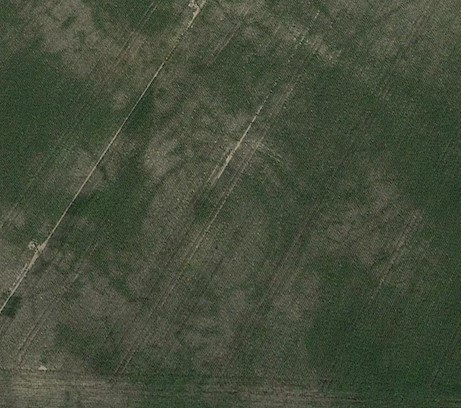

polish roundels (aka circular neolithic enclosure in Central Europe)
Drzemlikowice, Oława, Tylice, Nowe Objezierze
#neolithic#prehistory#stone age#archaeology#prehistoric europe#rondels#roundels#neolithic circular enclosures in central europe#stroked pottery culture#lengyel culture#earthworks#central europe#poland#archeology#my upl
102 notes
·
View notes
Link
8 notes
·
View notes
Photo

Lake Pergusa is a major wet zone in central Sicily and an important resting and wintering spot for migratory birds from all over the Mediterranean. The lake is the most important area in Sicily for the wintering of ducks and coots, and it hosts swans, herons, flamingos, cranes, and many other water species. Today, Lake Pergusa faces an environmental threat from an autorace track that has been built around its entire three-mile perimeter.
The twentieth-century discovery of the archaeological site known as Cozzo Matrice, a plateau situated less than a quarter mile from the lake, whose name means "hill of the Mother," has provided abundant evidence that Lake Pergusa was once the location of an important religious center dedicated to female deities. Ceramic material found there dates to as early as 4000 BCE, and remains of circular and elliptical huts overlooking the lake date to 2500 BCE. The presence of circular enclosures, which in Paleolithic and Neolithic Europe symbolized the "womb" of the female divinity, suggests that this site was probably sacred to a goddess or goddesses from very early times.
An important archaeological layer has been found dating to the fifth century BCE that reveals the joint influence of the indigenous Sicilians (or Sicels) and the Greeks who began colonizing the island in the eighth century BCE.
This layer contains the stone remains of a sanctuary and statuettes of either Demeter or Persephone (or both), as well as related sacred objects. At other villages near the lake -Zagaria, Juculia, and Jacobo- statuettes representing Demeter and/or Persephone dating from the sixth to third centuries BCE have also been found. Perhaps most significant, Lake Pergusa was closely connected with Enna, a nearby twin-peaked or double-breasted mountain town that was a celebrated religious center dedicated primarily to Demeter. Archaeologists generally agree that the Greeks easily superimposed their religion of Demeter and Persephone over the indigenous Sicilian cult at Lake Pergusa and Enna because it strongly resembled the earlier tradition; thus, these two goddesses or their precursors were associated with the lake going back as far as the Bronze Age, if not earlier. Ross Holloway notes that even the Greek cult at Pergusa retained indigenous Sicelian, rather than Greek, characteristics.'? With the commencement of Roman occupation of the island in the late third century BCE, the goddesses came to be known by their Roman names, Ceres and Proserpine, but their cult at Enna and Lake Pergusa continued.
Women served as important, and sometimes primary, leaders and ministrants of the religion both at Enna-Pergusa and throughout the island. A funerary plaque dedicated to a "priestess of Ceres" found on one of the mountain peaks of Enna indicates the prominence of women in religious leadership, as do the writings of historian Diodorus Siculus and Roman orator Cicero.
Diodorus and Cicero attest that the religion dedicated to Demeter and Persephone at Enna-Pergusa was characterized by elaborate festivals celebrating Sicily's agricultural cycle, particularly as it related to the production of wheat and barley, as well as rites centering on the human seasons of birth, growth, and death. It will become significant to this discussion that one of those rites was the Thesmophoria, an all-female rite honoring Demeter and Persephone that was also conducted in Greece. In Sicily, as elsewhere, Demeter was the goddess of growth and abundance, and Persephone was a goddess of both budding spring and death, or the underworld.
Several ancient literary renderings name Enna or its environs as the location of Persephone's abduction into the underworld by Hades. Key to this discussion is the fact that Roman poet Ovid names Lake Pergusa specifically as the precise spot where this took place. Ovid further describes the lake as a remarkable environment filled with forests, waterbirds, and wildly blooming flowers. [...]
The flower motif is also important because it may help us date the religious center at Lake Pergusa. Sicilian scholar Giuseppe Martorana believes that the ancient descriptions of Enna and/or Lake Pergusa as places where "flowers continually bloom" and "spring smiles eternally" refer to the preagricultural, hunter-gatherer epoch in the history of the island. Extrapolating from his assertion, this would place religious activity at the lake earlier than 6000 BCE, when it is documented that Sicilians began domesticating crops. Martorana hypothesizes that this was a time in which a pre-Greek version of Kore as maiden goddess of spring was the principal deity of Sicily. It is important to note that although she embodied the life-giving aspects of springtime, she would have been, at the same time, a goddess of death. Thus, says Martorana, Kore, or some earlier form of her, was probably the original goddess of Lake Pergusa-an independent, free-standing goddess who embodied the totality of the life and death cycle. He maintains that it was not until the cultural transition to agriculture that her supremacy gave way to that of Demeter, "Goddess of the technology of grain cultivation." With the flowers of Kore replaced by the grain of Demeter, the primary religious conception of the goddess moved from that of the parthenogenetic, self-fertilizing "virgin" to that of the "mother". Günther Zuntz details archaeological and literary evidence confirming that Persephone, or some earlier version of her, was indeed a very old, "pre-Greek" goddess who may well have been a -or the- principal deity of pre-Greek Sicily. Noting that the Sicilians of the late Paleolithic and Neolithic periods put great spiritual emphasis on death and rebirth, as evidenced by the centrality of tomb-wombs in their sacred life, Zuntz affirms that Kore-Persephone was a holdover of the "silent Goddess of Life and Death" of the early peoples of the island. Significantly, archaeologists Paolo Orsi and Bernabo Brea noted in the first half of the twentieth century that the entire region surrounding Pergusa was one large necropolis from the eighth through sixth centuries BCE. I thus suggest that the lake may have symbolically represented to ancient inhabitants the chthonic, underworldly regions, and the nearby mountaintop of Enna, where Demeter's worship predominated, represented the upperworldly realms. [...]
The mythological motif of Persephone's gathering flowers in both the Homeric Hymn to Demeter and the Metamorphoses is also extremely significant here. I believe this is a reference to the picking of entheogenic plants, the ingesting of which propels Persephone's journey into the underworldly realms. In the Hymn, it is her picking of the narcissus in particular that initiates the "abduction" by (into) Hades. Ann Suter notes that the etymological root of narcissus is nark, meaning "grow numb, stiff, dead." This and the fact that nark is also the root for narcotic strongly suggest that Persephone's descent describes female shamanic initiation induced by sacred medicines to help one shift consciousness, become "dead," and enter the otherworld/underworld for the purpose of connecting with divine consciousness and obtaining wisdom.
Again, following on Martorana, the reference to "gathering" may place the origins of such a ritual in the preagricultural Paleolithic era. Although Ovid does not mention the narcissus (rather, he speaks of violets or lilies), I believe he is nevertheless referencing the activity of picking sacred medicinal flowers or herbs in conjunction with puberty initiation. If the posited Paleolithic time period is correct, this would make such a ritual very ancient indeed.
Cicero intimates that "mysterious rites" were conducted in connection with Demeter and Persephone at Enna, suggesting that in later Greco Roman times, formal mystery rites akin to the nine-day Greater Mysteries of Eleusis may have been held there (and, again, by extension, at Lake Pergusa). Given the level of intensity of the initiatory experience at Eleusis, I agree with scholars who contend that the Greek mysteries most likely involved the use of entheogens; and, if the Sicilian mystery rites were indeed similar to their Greek counterparts, they thus involved the use of such sacred medicines as well. I therefore suggest that such mystery rites-both at Enna-Pergusa and in Greece-may have originated in more remote times in the kinds of female initiatory rituals I am describing here, in which women may have used the sacred medicines they discovered and developed through their intimate work with plants.
Marguerite Rigoglioso, Persephone's Sacred Lake and the Ancient Female Mystery Religion in the Womb of Sicily, p. 7-9; 11-12; 19-20
#mythology#history#women#Persephone#demeter#mythologyedit#pergusa#province of enna#anthropology#Greek Sicily
21 notes
·
View notes
Text
Prehistoric Religion
Prehistoric religions are the religious beliefs and practices of prehistoric peoples. The term may cover Paleolithic religion, Mesolithicreligion, Neolithic religion and Bronze Age religions.
Paleolithic
Intentional burial, particularly with grave goods, may be one of the earliest detectable forms of religious practice (the onset of burial itself being a canonical indicator of behavioral modernity) since, as Philip Lieberman suggests, it may signify a "concern for the dead that transcends daily life".
A number of archaeologists propose that Middle Paleolithic societies such as Neanderthal societies may also have practiced early forms of totemism or of animal worship. Emil Bächler in particular suggests (based on archeological evidence from Middle Paleolithic caves) that a widespread Middle Paleolithic Neanderthal bear-cult existed (Wunn, 2000, p. 434-435). A claim that evidence was found for Middle Paleolithic animal worship c 70,000 BCE (originating from the Tsodilo Hills in the African Kalahari desert) has been denied by the original investigators of the site. Animal cults in the following Upper Paleolithic period, such as the bear cult, may have had their origins in these hypothetical Middle Paleolithic animal cults.
Animal worship during the Upper Paleolithic intertwined with hunting rites. For instance, archaeological evidence from Paleolithic art and from bear remains reveals that the bear cult apparently had a type of sacrificial bear ceremonialism in which a bear was shot with arrows, then finished off with a shot in the lungs and ritualistically buried near a clay bear-statue covered by a bear fur, with the skull and the body of the bear buried separately.

Neolithic
There are no extant textual sources from the Neolithic era, the most recent available dating from the Bronze Age, and therefore all statements about any belief systems Neolithic societies may have possessed are glimpsed from archaeology.
Jacques Cauvin suggested that the Neolithic Revolution was influenced by an important theme he termed the "Revolution of the Symbols", suggesting the birth of "religion" in the Neolithic. He argued that Neolithic humans were influenced by a change in thinking as much as changes in the environment and noted a series of stages in this process. His work suggested important concepts in the evolution of human thinking, by examining figurines and early art depicting first women as goddesses and bulls as gods, he suggested several important ideas about the evolution of perception and duality.
The structures known as Circular Enclosures built in Central Europe during the 5th millennium BCE have been interpreted as serving a cultic function. In the case of the Goseck circle, remains of human sacrifice were found. Many of these structures had openings aligned with sunset and/or sunrise at the solstices, suggesting that they served as a means of maintaining a lunisolar calendar. The construction of Megalithic monuments in Europe also began in the 5th millennium, and continued throughout the Neolithic and in some areas well into the early Bronze Age.
Marija Gimbutas, pioneer of feminist archaeology, put forward a notion of a "woman-centered" society surrounding "goddess worship" in Neolithic Europe. The Neolithic "matristic" cultures would have been replaced by patriarchy only with the arrival of the Bronze Age. Gimbutas' views on this matter do not have widespread support today.
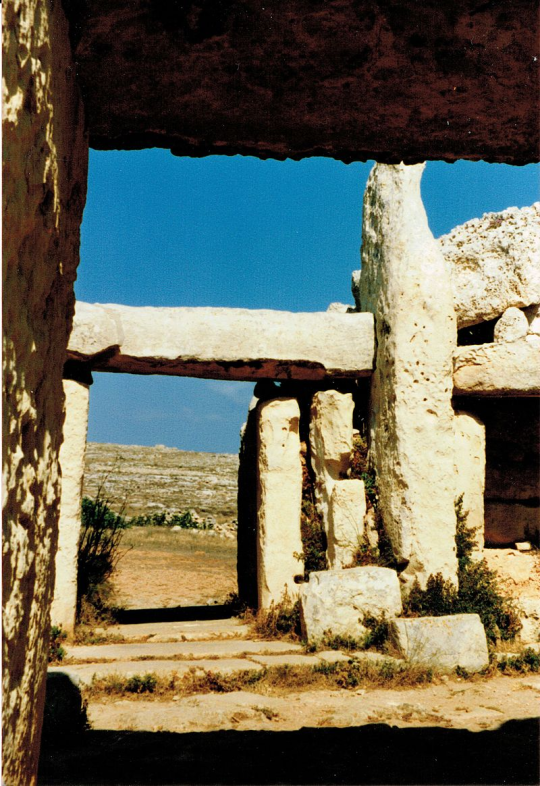
Source
469 notes
·
View notes
Text
English History (Part 4): Bronze Age
Bronze Age (2500 – 800 BC)
Around 2200 BC, the first stone circle was created at Stonehenge. This change from wood to stone may have been part of a great cultural movement, one that resulted in the building of monumental enclosures in other sites; the decline of ancestor worship; and bouts of warfare between opposing groups.
The bodies of two adults (male and female) and two children have been found in a single grave in Peterborough. In Dorset, several bodies were found lying in a ditch, with a rampart fallen on top of them. One of them had been killed by an arrow.
The construction of Stonehenge was the largest program of public works in the history of England, and the most drawn-out. The stone circle built in 2200 BC was a series of bluestones, mostly igneous in origin, and considered to have magical healing properties.
Around 2100 BC, the bluestones were taken down and replaced by 30 sarsen stones, in a circle around five pairs of trilithons, which were themselves arranged in a horseshoe pattern. At around the same time, a wooden henge (a circular monument) of 24 obelisks was built less than 800m away from the stone circle. This may have been a burial centre or the site of some other ritual activity.
Bluestonehenge (another henge & stone circle) was built 1.6km to the south-east, along the bank of the Avon River. A large village was built, less than 3.2km away – this may have been a ritual centre, a place of healing, a lodging for pilgrims, or a home for those who set up the sarsen stones. Clearly Salisbury Plain was the site of communal and spiritual settlement on a very large scale.
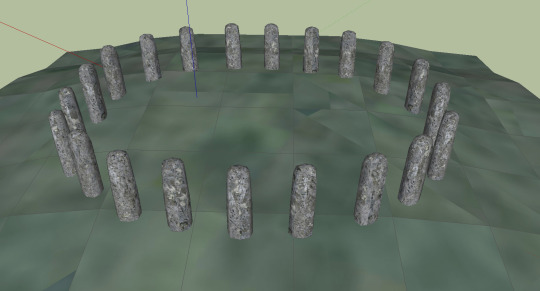
Digital reconstruction of Bluestonehenge. No stone remains aboveground.
Also around 2100 BC, the Amesbury Archer was buried. He is also called the “king of Stonehenge”. His grave contained over 100 artifacts, including gold ornaments, copper knives, boar tusks and pots. His body was crouched in a foetal position, and flint arrowheads were scattered over him.
The Amesbury Archer would have been a tribal chieftain, but oxygen isotope analysis has shown that he grew up in the colder regions of Northern Europe. It is not known why a foreign king was buried on Salisbury Plain. His body shows evidence of an abscess and a painful bone infection. He may have been on pilgrimage, or he may have crossed the sea to be healed. Or he may have ruled here as one of the tribal chieftains who were not necessarily confined to one region (as there were no countries or nations as we have now).

The Amesbury Archer and grave-goods.
Stonehenge's last construction phase was around 1600 BC. Two circles of standing stones were planned, but only the pits/holes were dug for them. So the structure of Stonehenge has changed over 1,200 years, and possibly its purpose as well. It may have been a burial ground, a site of public ceremonial and ritual, a centre of pilgrimage and ritual healing, a great observatory and celestial clock. We do not know.
However, in all of these ears, Stonehenge is evidence of a controlling power that could organize many people in this project. There was a hierarchical society with an elite group at the top (tribal or priestly) that could force or persuade thousands of people into building Stonehenge (and other ritual sites). Stonehenge would have taken millions of hours of labour. The bluestones came from the Preseli Hills in south-west Wales, about 320km away. Land, material resources and labour were governed by some form of central control.

Stonehenge quarry.
It is possible that during the 1,200 years of Stonehenge's construction phases, communal burials were being replaced by individual burials – the Amesbury Archer is one example. In some graves, the chieftain's body is accompanied by weapons; in others, the body is surrounded by goods. These would have been the graves of leaders and high priests, often buried with their immediate families. England had become an aristocratic society, rather than a tribal one.
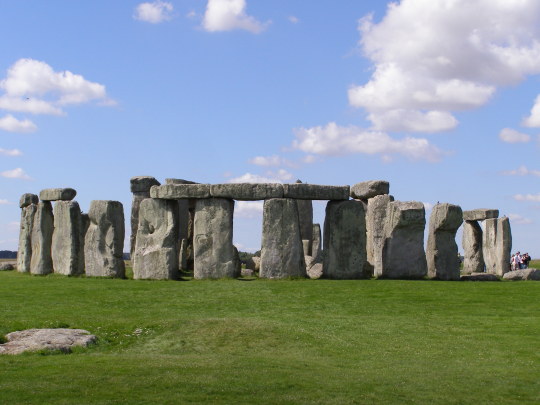
Stonehenge today.
-------
The Bronze Age cultivation of the landscape can still be seen, especially from the air. The banks & ditches of hundreds of rectangular fields can be seen. They were photographed from the air for the first time in 1929, and a lost world was revealed.
The uplands and downlands of southern Britain were laid out in fields, with hedges and stone walls stretching for miles. Among these ditched fields were drove-ways and waterholes. Central planning would have been essential for this level of land planning. Thousands of square miles of land were laid out in this way.
This intense cultivation is the strongest evidence for a steady population increase. By 1900 BC (600yrs into the Bronze Age) there were perhaps a million people, and when Julius Caesar invaded in 55 BC (near the end of the Iron Age), there were over 2 million people.
England was an agricultural society, with regional variations. The cultivated land has continued to be used as productive arable land ever since. Woodland was cleared, and pastureland was created with grass. There were more sheep than there would be in 1600 AD. There was little monumental construction – working the land was now a more important activity.
There were settlements everywhere, most of them situated away from the monumental sites. Single households and small hamlets were common. Enclosures were surrounded by a fence or ditch. Hut circles were groups of round stone houses with beehive roofs. People who lived there burned peat, and the hut circles included farmyards (or perhaps they were nearby?)
The Bronze Age people buried their dead in family units, cremating the bodies and placing the ashes in decorated urns. The cemeteries of the Late Bronze Age (from c. 1300 BC) are known as urn fields.
Men wore a tunic known as a “kirtle”, with a woollen cloak above it. Women wore a tunic and jacket, also covered by a woollen cloak. Their shoes were made of skin, and the men wore woollen caps. Higher-status women wore elaborate jet necklaces. One grave has evidence of a woman who had a concealed pad to bolster her hair. Higher-status men and women wore gold & bronze ornaments, and blue beads imported from Egypt. They also imported amber jewellery from the Baltic region. There was quite a lot of international trade in Bronze Age England.
The people ate soups, stews and dressed meat; and a type of porridge made of wheat, barley and oats. Alcoholic drinks such as beer and wine were an important part of their diet. They also ate hazelnuts, herbs, seaweed, and varieties of berries.
The focus of ceremony & worship shifted from the sky to the earth. The cultivation & increased use of the land would have increased the importance & significance of fertility rituals. Specific attention was given to water and watery places, including rivers, springs, marshes and fens.
Bronze Age weapons & other artifacts have been found in the Thames. The offerings of weapons, ornaments and bones were kept separate and distinct. At Eton, there are many skulls, but no metal. Tools were left in dry locations, and weapons in wet locations. Wooden platforms & causeways were built beside the river – they were part of the sacred space in which the peoples' priests dwelled.

Leaf-shaped bronze (copper-alloy) sword (Late Bronze Age).
Burial mounds and henge monuments have been located by rivers throughout prehistory. 368 Neolithic axes have been found in the Thames. The Bronze Age river offerings may have been part of a rite to gain the favour of the dead, i.e. part of ancestor worship. If the dead were believed to cross between the world of the living and the world of the dead, they would have a particular affinity with the river – the river would give access to the underworld though many passages, and it springs fresh and renewed froms its source.
During the Bronze Age, the weather was growing cooler and wetter.
Weapons have been found all over England – spearheads, socketed axes, rapiers, and (at a slightly later date) swords. Stirrups have been found; there is evidence of harnesses and bronze fittings for horses. There were chariots as well – traces of wheel ruts have been found at Peterborough that would have supported a vehicle with a width of one metre.
The evidence points to a warrior aristocracy, in a kingdom or group of sub-kingdoms stretching from Dorset to Sussex. The middle & late Bronze Age is roughly contemporaneous with the culture of Homer's Troy, with the same focus on kings & warriors, feasting and ritual battle. It would have been a warrior society with small-scale sporadic fighting between elites, gift exchanges between leaders, and tribute (in the form of food) from the subject population. This would have been one of the reasons why the land was farmed so extensively.
Defended settlements were found everywhere, as well as other enclosures that contained buildings. These were the prototypes for the Iron Age hill forts of southern England. In Dorset, a fence made out of great tree trunks was built around an area of 11 acres (4.4 hectares). It was set in a trench about 3 metres deep.
Strong regional identities & divisions were already being formed. The Thames Valley had access to the European mainland, which gave it an advantage in trade. This helped the region to eclipse the agricultural wealth of the Salisbury Plain. Northern England was focused on stock-raising, whereas southern England focused on cereal production. Trade encouraged interdependence between regions.
Commerce of all kinds was increasing, and this was very important. Trade leads to the growth of civilizations; it enables wars; it encourages technological growth; it creates towns & cities. Some types of swords were manufactured in western France, and ended up in eastern England. Also imported to England were highly-embellished barbecue spits from Spain, metalwork from Mycenae in Greece, and gold ornaments from Ireland.
In turn, England exported linen, woollen fabrics, slaves and hunting dogs to Europe. Children worked in Cornwall's tin mines, using bones and hammer-stones to dig out the ore. The metal was then sent to England's coastal ports for shipment to the continent.
When tin is added to molten copper, bronze is formed. The new technology changed everything, from cutting down forests to building houses to fighting. There were even bronze razors, with oil used as a lubricant for shaving.
Many Bronze Age settlements & cemeteries used the same sites as the Neolithic Period, and Bronze Age settlements were continuously in use throughout the Irone Age. The Iron Age people consistently respected the burial mounds and boundary lines of those who had come before them.
#book: the history of england#history#prehistory#architecture#agriculture#crop farming#culinary history#fashion#economics#trade#slavery#labour#child labour#mining#bronze age#prehistoric architecture#britain#prehistoric britain#bronze age britain#wiltshire#cornwall#stonehenge#amesbury archer#tin#bronze
8 notes
·
View notes
Text
big shout out to people of the Lengyel culture for coming up with the idea of roundels 💕❤️💓
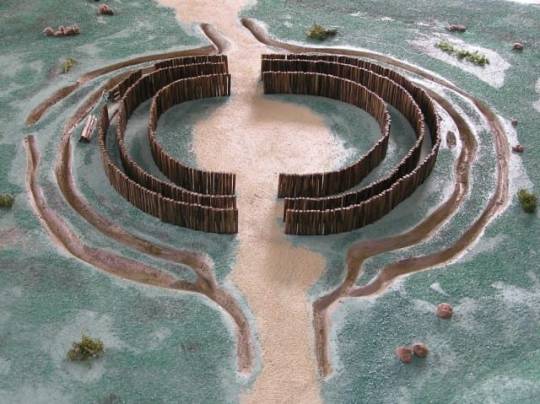


6 notes
·
View notes
Text

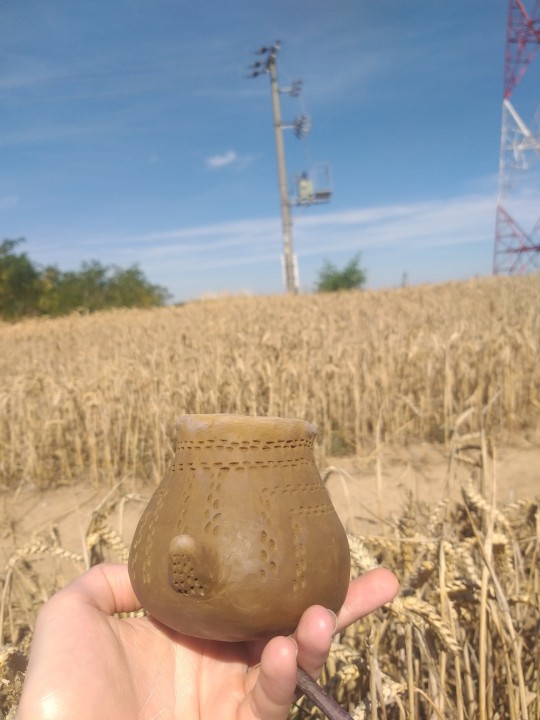
We stopped in the middle of the rondel to decorate our half finished pots with a standard Stroked Pottery Culture ornaments. Very mystical experience! I could clearly see the 4 gates and the system of ditches people made almost 7 thousands years ago! And the stylus im using was sharpened with a flint knife...
#stroked pottery culture#linear pottery culture#neolithic#megalithic structure#neolithic circular enclosures in central europe#experimental archaeology#pottery#place of power#rondel#my pic#liveblogging#excavations#moje#transcendental#the passage of time#but this time being aware of time passing is a positive thing - for the first tims in forever for me....
1 note
·
View note
Text
We are going on a trip to see the rondel!!! (Neolithic circular enclosure in Central Europe)
#neolithic circular enclosures in central europe#rondel#neolithic#archaeology#liveblogging#moje#neolithic observatory#megalithic structure
1 note
·
View note